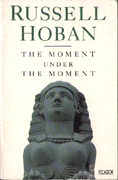

1. Foreword. On the nature of reality, the ungraspable real reality: the moment under the moment which can't be put into words.
 Léonie |
4. Schwarz. In which the protagonist is accompanied home by a black stone lion from the Oriental Antiques room of the British Museum; they discuss, among other things, Thelonious Monk.
5. The Raven. Conversations with a raven at the zoo, about "the vast blackness of the bird," and a journey to a place before form and life, "fast asleep and dancing in the dim red caverns of sleep." Much relevance to Fremder.
6. The Colour of Love. The story of a painter in Venice, and the color she sees behind closed eyes.
7. Dream Woman. Three encounters with a woman from the realm of dream.
8. Dark Oliver. In which a young boy enters a hollow tree on the isle of Paxos, and falls into a deep blackness.
9. The Ghost Horse of Genghis Khan. In which a boy collaborates with his father on a story about Genghis Khan, galloping for his life on a red roan. A sibling tale to The Lion of Boaz-Jachin and Jachin-Boaz?
12. Household Tales by the Brothers Grimm. Introduction to the 1977 Picador Edition of Grimm stories.
13. 'I, that was a child, my tongue's use sleeping...' Reflections on "The American Dream," written for the June 1984 Seminar of the Israel Association of American Studies in Tel Aviv. Walt Whitman, Edward Hopper, Hermes, and "the house of childhood": "a place where we test words and images and ideas to find out what rings true."
14. With a Choked Cry. A recollection of unforgettable drawings from lost childhood books.
 Snowy Owl |
16. Blighter's Rock. On "blighters" and how they sometimes get "rocked." The terror of blank paper and how writers deal with it. Cameos by Rilke, H. P. Lovecraft and Freddy Krueger.
17. The Bear in Max Ernst's Bedroom or The Magic Wallet. Keynote address for the Sixth Annual Literary Conference of the Manitoba Writers' Guild in 1987. On the craziness inherent in the human situation, and the necessity of listening to what wants to speak to you. How what exists in the mind is real, because the mind is the only place there is.
18. Word Pix. On a room with five pictures of empty roads on the wall, and a Max Klinger etching in which a skeleton is tied to the tracks. "'Oh my god!' it screams. 'Oh my god! If the train hits me I'll come alive!'"
19. Fragments of a Lament for Thelonious Monk. "In The Five Spot in Cooper Square I sat long ago in the blue smoke and the buzz of night murmurers and saw you under your magical hat at the helm, your keyboard was the wheel by which you steered precariously our frail vessel on the edgelines of the actual."
20. Portknockie. How a town in Scotland embodies the idea of living "on the sea, by the sea, for the sea, and with the sea..." The glimpse of an owl, the idea of return, and an inexplicable gladness.
21. Footplacers, London Transport Owls, Wincer-Boise. The real dirt on what lives underground, and in the underground.
22. Mnemosyne, Teen Taals, and the Tottenham Court Road. Cycles of time in Indian music, the etymology of memory, and how the world flees from us in all directions. "Possibly the only keeping is a constant letting go." How photographing a bull in a mountain monestary interfered with "the moving on of being."
23. Certain Obsessions, Certain Ideas. "Certain images persist in the mind..." Thoughts on "the famous drawing of the so-called sorcerer in the cave of Les Trois Frères," Hermes, Perseus paying a visit to Fay Wray, and of course, the head of Orpheus. Early sketch material prior to The Medusa Frequency, including a police interview with the head. Also, a thinking bomb that demands a true story about a man and a woman.
24. Masada One Morning. A visit to Masada, where in AD 73, 960 Jewish Zealots, men, women and children, decided to die rather than submit to the Romans. How the past never goes away, and keeps on happening.
Back to The Moment Under The Moment.
Back to The Head of Orpheus: a Russell Hoban Reference Page (home page).
Russell Hoban's other novels and collections: